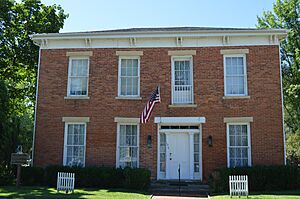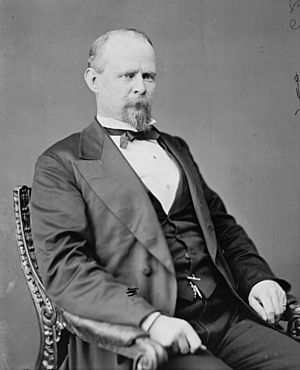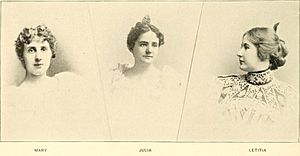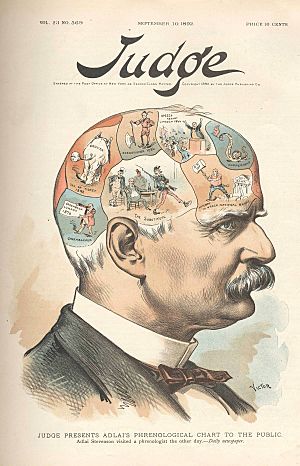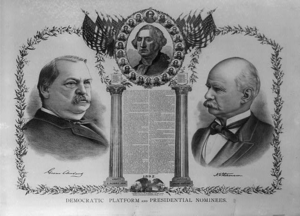Adlai Stevenson I facts for kids
Quick facts for kids
Adlai Stevenson
|
|
|---|---|

Stevenson, c. 1892
|
|
| 23rd Vice President of the United States | |
| In office March 4, 1893 – March 4, 1897 |
|
| President | Grover Cleveland |
| Preceded by | Levi P. Morton |
| Succeeded by | Garret Hobart |
| 21st First Assistant United States Postmaster General | |
| In office August 1, 1885 – March 4, 1889 |
|
| President | Grover Cleveland |
| Preceded by | Malcolm Hay |
| Succeeded by | James S. Clarkson |
| Member of the U.S. House of Representatives from Illinois's 13th district |
|
| In office March 4, 1879 – March 3, 1881 |
|
| Preceded by | Thomas F. Tipton |
| Succeeded by | Dietrich C. Smith |
| In office March 4, 1875 – March 3, 1877 |
|
| Preceded by | John McNulta |
| Succeeded by | Thomas F. Tipton |
| State's Attorney of Woodford County, Illinois | |
| In office 1865–1869 |
|
| Personal details | |
| Born |
Adlai Ewing Stevenson
October 23, 1835 Christian County, Kentucky, U.S. |
| Died | June 14, 1914 (aged 78) Chicago, Illinois, U.S. |
| Resting place | Evergreen Cemetery |
| Political party | Democratic |
| Spouse | Letitia Green (m. 1866) |
| Relations | Stevenson family Lewis Stevenson (Son) Adlai Stevenson II (Grandson) Adlai Stevenson III (Great-Grandson) Adlai Stevenson IV (Great-Great-Grandson) |
| Children | 4, including Lewis |
| Education | Centre College (BA) |
| Signature | |
Adlai Ewing Stevenson (October 23, 1835 – June 14, 1914) was an American politician. He served as the 23rd Vice President of the United States from 1893 to 1897. Before that, he was a U.S. Representative for Illinois. He also worked as the assistant United States Postmaster General.
During his time as assistant postmaster general, he made changes to the postal service staff. This made some people in Congress unhappy. However, it also made him a popular choice to run with Grover Cleveland in the 1892 election. They won, and he became Vice President.
As Vice President, he was known for being fair and dignified. In 1900, he ran for Vice President again with William Jennings Bryan. This made him one of the few people to run for Vice President with two different presidential candidates. Adlai Stevenson was the grandfather of Adlai Stevenson II, who was a governor of Illinois and ran for president twice.
Contents
Early Life and Education
Adlai Stevenson was born on a family farm in Christian County, Kentucky. When he was 14, a harsh frost ruined his family's tobacco crop. Two years later, his father freed their few slaves. The family then moved to Bloomington, Illinois, where his father started a sawmill.
Stevenson went to Illinois Wesleyan University and later graduated from Centre College in Danville, Kentucky. After his father passed away, Stevenson returned to Illinois to manage the sawmill. He then studied law with a lawyer in Bloomington. In 1858, he became a lawyer and started his practice in Metamora, Illinois.
As a young lawyer, Stevenson met famous Illinois attorneys like Stephen A. Douglas and Abraham Lincoln. He supported Douglas in his 1858 Senate race against Lincoln. Stevenson also spoke out against a group that was against immigrants. This helped him gain support from German and Irish communities in Illinois. Even though his area was mostly Republican, Stevenson's friendly personality made him popular.
Marriage and Political Career (1860–1884)
Stevenson's first public job was as an assistant in a court during the Civil War. In 1864, he was chosen to vote for the Democratic presidential candidate. He was also elected as a district attorney that year.
In 1866, he married Letitia Green. They had three daughters and one son, Lewis. Letitia helped start the Daughters of the American Revolution. This group aimed to help unite the country after the Civil War.
After his term as district attorney, Stevenson started a law firm with his cousin. They moved back to Bloomington, Illinois. Their law firm became one of the most well-known in the state.
In 1874, the Democratic Party chose Stevenson to run for the United States Congress. He was well-liked by people from both parties. He also had influence in the local Masonic group. Stevenson ran against the current Republican, John McNulta. He criticized McNulta for supporting high taxes and a law that increased congressmen's salaries. Stevenson won the election and joined the 44th United States Congress. This was the first time Democrats controlled Congress since the Civil War.
Stevenson tried to get re-elected in 1876 but lost. In 1878, he ran again and won, returning to Congress. He lost his next two elections in 1880 and 1882. He thought about running again in 1884, but the district boundaries were changed, making it harder for a Democrat to win.
Between his time in Congress, Stevenson became more important in Bloomington. He became a leader in his Masonic group. In 1881, he started a Democratic newspaper called the Bloomington Daily Bulletin. He also managed a bank and a coal company. The coal company even created a town called Stevensonville for its workers.
Working for President Cleveland (1884) and the Post Office
Stevenson became friends with William Freeman Vilas, a rising Democrat and friend of Grover Cleveland. Stevenson supported Cleveland at the 1884 Democratic National Convention. When Cleveland won the election, Vilas became postmaster general. Stevenson was then appointed as the assistant postmaster general.
In this new job, Stevenson was in charge of hiring and firing many people in the postal service. He removed thousands of political opponents and replaced them with Democrats. Before Cleveland left office, he tried to make Stevenson a judge. However, Republicans in the Senate stopped this from happening. They were still upset about Stevenson replacing Republican postal workers. Stevenson was disappointed and returned to Bloomington.
Vice Presidency (1893–1897)
Cleveland was chosen to run for President again in 1892. At that time, the Vice President's job was not seen as very important. However, Stevenson's family and friends pushed for him to be nominated. The Mayor of Chicago also supported Stevenson. Stevenson was chosen as Cleveland's running mate.
Stevenson traveled across the country with his wife to campaign. Cleveland's team sent Stevenson to the South to gain support. With his Kentucky background, Stevenson was popular there. He also spoke out against a proposed law that would have given voting rights to Black people in the South. The Cleveland-Stevenson team won the election.
Some people hoped that Cleveland's second term would bring reforms. However, Vice President Stevenson continued to help Democrats get jobs in the Post Office. He once told Treasury officials not to trust his written recommendations for jobs. He said if he truly supported someone, he would tell them in person.
In the summer of 1893, President Cleveland had secret surgery for mouth cancer. He wanted to keep it a secret to avoid a financial panic. Stevenson did not know how close he came to becoming president that summer.
Adlai Stevenson enjoyed being Vice President. He led the U.S. Senate and was praised for being fair. He was tall and always polite. While he often visited the White House, Stevenson felt he was more of a "neighbor" to the President than a close advisor. President Cleveland joked that Stevenson had surrounded himself with people who disagreed with Cleveland's money policies. Cleveland even joked about resigning and letting Stevenson take over because the economy was so bad.
Later Years (1897–1914)
Presidential Campaigns of 1896 and 1900
Stevenson was considered a possible candidate for president in 1896. He led the Illinois group at the Democratic National Convention. However, a younger man from Nebraska, William Jennings Bryan, became very popular with his "Cross of Gold" speech. Bryan was nominated for president. Many Democrats who supported Cleveland did not support Bryan. But Stevenson remained loyal and supported Bryan.
In 1900, Bryan was again the top choice for president. Many thought Indiana Senator Benjamin Shively would be his running mate. But Shively didn't want to be part of a losing ticket. So, Stevenson became the leading choice for Vice President. He had run with Cleveland in 1892, and now he ran with Cleveland's opponent, Bryan. Stevenson, being 25 years older than Bryan, brought experience to the ticket. However, they lost badly to William McKinley and Theodore Roosevelt.
Stevenson was one of only a few U.S. vice presidents to run for the office again with a different presidential candidate.
Final Years
After the 1900 election, Stevenson went back to his law practice in Illinois. He made one last attempt to win office in 1908, running for governor of Illinois at age 73. He lost by a small margin. In 1909, he helped a distance learning school called La Salle Extension University. After that, he retired to Bloomington. He passed away in Chicago on June 14, 1914, at 78 years old. He is buried in Evergreen Cemetery in Bloomington, Illinois.
Stevenson's son, Lewis G. Stevenson, was the Illinois secretary of state. His grandson, Adlai Stevenson II, ran for President of the United States twice and was Governor of Illinois. His great-grandson, Adlai Stevenson III, was a U.S. senator from Illinois.
Legacy
In 1962, Stevenson's college, Centre College, named a new building "Stevenson House" in his honor. They had given him an honorary degree in 1893.
Images for kids
See also
 In Spanish: Adlai E. Stevenson I para niños
In Spanish: Adlai E. Stevenson I para niños


